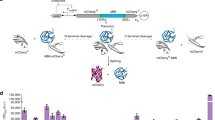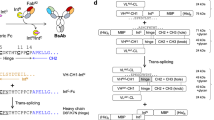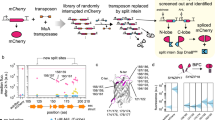Abstract
A self-cleaving element for use in bioseparations has been derived from a naturally occurring, 43 kDa protein splicing element (intein) through a combination of protein engineering and random mutagenesis. A mini-intein (18 kDa) previously engineered for reduced size had compromised activity and was therefore subjected to random mutagenesis and genetic selection. In one selection a mini-intein was isolated with restored splicing activity, while in another, a mutant was isolated with enhanced, pH-sensitive C-terminal cleavage activity. The enhanced-cleavage mutant has utility in affinity fusion-based protein purification. These mutants also provide new insights into the structural and functional roles of some conserved residues in protein splicing.
This is a preview of subscription content, access via your institution
Access options
Subscribe to this journal
Receive 12 print issues and online access
$209.00 per year
only $17.42 per issue
Buy this article
- Purchase on Springer Link
- Instant access to full article PDF
Prices may be subject to local taxes which are calculated during checkout



Similar content being viewed by others
References
Perler, F.B. et al. Protein splicing elements: inteins and exteins—a definition of terms and recommended nomenclature. Nucleic Acids Res. 22, 1125–1127 (1994).
Gimble, F.S. Putting protein splicing to work. Chem. Biol. 5, R251–R256 (1998).
Chong, S. et al. Single-column purification of free recombinant proteins using a self-cleavage affinity tag derived from a protein splicing element. Gene 192, 271–281 (1997).
Chong, S. et al. Utilizing the C-terminal cleavage activity of a protein splicing element to purify recombinant proteins in a single chromatographic step. Nucleic Acids Res. 26, 5109–5115 (1998).
Dalgaard, J.Z. et al. Statistical modeling and analysis of the LAGLIDADG family of site-specific endonucleases and identification of an intein that encodes a site-specific endonuclease of the H-N-H family. Nucleic Acids Res. 25, 4626–4638 (1997).
Duan, X., Gimble, F.S. & Quiocho, F.A. Crystal structure of PI-SceI, a homing endonuclease with protein splicing activity. Cell 89, 555–564 (1997).
Derbyshire, V. et al. Genetic definition of a protein-splicing domain: functional mini-inteins support structure predictions and a model for intein evolution. Proc. Natl. Acad. Sci. USA 94, 11466–11471 (1997).
Chong, S & Xu, M.-Q. Protein splicing of the Saccharomyces cerevisiae VMA intein without the endonuclease motifs. J. Biol. Chem. 272, 15587–15590 (1997).
Shingledecker, K., Jiang, S. & Paulus, H. Molecular dissection of the Mycobacterium tuberculosis RecA intein: design of a minimal intein and of a trans-splicing system involving two intein fragments. Gene 207, 187–195 (1998).
Chong, S. et al. Protein splicing involving the Saccharomyces cerevisiae VMA intein: the steps in the splicing pathway, side reactions leading to protein cleavage and establishment of an in vitro splicing system. J. Biol. Chem. 271, 22159–22168 (1996).
Xu, M. & Perler, F.B. The mechanisms of protein splicing and its modulation by mutation. EMBO J. 15, 5146–5153 (1996).
Stoddard, B.L. & Pietrokovski, S. Breaking up is hard to do. Nat. Struct. Biol. 5, 3–5 (1998).
Chong, S., Williams, K.S., Wotkowicz, C. & Xu, M. Modulation of protein splicing of the Saccharomyces cerevisiae vacuolar membrane ATPase intein. J. Biol. Chem. 273, 10567–10577 (1998).
Shao, Z. & Arnold, F.H. Engineering new functions and altering existing functions. Curr. Opin. Struct. Biol. 6, 513–518 (1996).
Belfort, M. & Pedersen-Lane, J. A genetic system for analyzing E. coli thymidylate synthase. J. Bacteriol. 160, 371–378 (1984).
Davis, E.O., Jenner, P.J., Brooks, P.C., Colston, M.J. & Sedgwick, S.G. Protein splicing in the maturation of the M. tuberculosis RecA protein: a mechanism for tolerating a novel class of intervening sequence. Cell 71, 201–210 (1992).
Derbyshire, V., Kowalski, J.C., Dansereau, J.T., Hauer, C.R. & Belfort, M. Two-domain structure of the td intron-encoded endonuclease I-TevI correlates with the two-domain configuration of the homing site. J. Mol. Biol 265, 494–506 (1997).
Klabunde, T., Sharma, S., Telenti, A., Jacobs, W.R. & Sacchettini, J.C. Crystal structure of gyrA intein from Mycobacterium xenopi reveals structural basis of protein splicing. Nat. Struct. Biol. 5, 31–36 (1998).
Pietrokovski, S. Conserved sequence features of inteins (protein introns) and their use in identifying new inteins and related proteins. Protein Sci. 3, 2340–2350 (1994).
Dalgaard, J.Z., Moser, M.J., Hughey, R. & Mian, I.S. Statistical modeling, phylogenetic analysis and structure prediction of a protein splicing domain common to inteins and hedgehog proteins. J. Comput. Biol. 4, 193–214 (1997).
Horton, R.M., Cai, Z., Ho, S.N. & Pease, L.R. Gene splicing by overlap extension: Tailor-made genes using the polymerase chain reaction. Biotechniques 8, 528–536 (1990).
Acknowledgements
This work was supported by NIH grants GM39422 and GM44844 to M.B., a Howard P. Isermann fellowship through the Department of Chemical Engineering, Rensselaer Polytechnic Institute to D.W., and a gift from Baxter Healthcare to G.B. The authors acknowledge the contributions of the Wadsworth Center Molecular Genetics Core and thank Drs. Richard Lease for many valuable discussions, David Shub for reading the MS, and Monica Parker for sound advice.
Author information
Authors and Affiliations
Corresponding author
Rights and permissions
About this article
Cite this article
Wood, D., Wu, W., Belfort, G. et al. A genetic system yields self-cleaving inteins for bioseparations. Nat Biotechnol 17, 889–892 (1999). https://doi.org/10.1038/12879
Received:
Accepted:
Issue Date:
DOI: https://doi.org/10.1038/12879
This article is cited by
-
A novel protein purification scheme based on salt inducible self-assembling peptides
Microbial Cell Factories (2023)
-
An alternative domain-swapped structure of the Pyrococcus horikoshii PolII mini-intein
Scientific Reports (2021)
-
The Effects of Self-cleavage Intein-ELK16 Tag in the Transcript Steric Hindrance of IFN
Indian Journal of Clinical Biochemistry (2021)
-
Intein-mediated recombinant expression of monomeric B22Asp desB30 insulin
BMC Biotechnology (2020)
-
Optimization and One-Step Purification of Recombinant V Antigen Production from Yersinia pestis
Molecular Biotechnology (2020)



